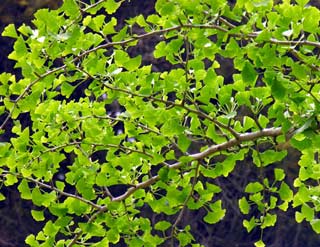The mystery of ginkgo tree
Ginkgo tree (ginkgo biloba), famous for its long-lasting healing and healing properties, is considered the oldest tree in the world that appeared 300 million years ago in a time when dinosaurs existed.
 Ginkgo biloba is the oldest tree in the world that still contains mysteries. (Photo: parks.it) Today, scientists discover a strange new thing that the tree also contains a parasitic algae that no plants receive. This algae is found in all ginkgo trees present on our planet.
Ginkgo biloba is the oldest tree in the world that still contains mysteries. (Photo: parks.it) Today, scientists discover a strange new thing that the tree also contains a parasitic algae that no plants receive. This algae is found in all ginkgo trees present on our planet.
Ginkgo trees come from China and have been used in traditional medicine for thousands of years. In the 1990s, many studies have demonstrated that extracts from this herb help improve cognitive abilities in dementia patients. Today, plants are used to treat dementia as well as diseases from depression to circulatory disorders.
When studying plants, scientists recorded the presence of a symbiotic algae .
Scientists discovered this in 2002 when a French pharmacologist at the University of François Rabelais in Tours noted that some transplanted ginkgo cells sometimes turn green.
Deep analyzes have allowed the assertion that living ginkgo cells contain algae 'phantom': these are non-nuclear and strayed cell frames. But when these cells die, the ghosts resurrect and turn into photosynthetic algae.
This strange algae has been discovered in all ginkgo trees observed, regardless of their origin. Symbiotic phenomenon is present in all embryos and reproductive tissues but not in leaves.
Scientists do not explain how this phenomenon works, they argue that the algae depend on ginkgo trees to live and on the contrary provide plants with compounds that are used as medicines.
According to the researchers, this symbiosis has existed for more than 100 million years.
VN
- Ancient 1,400 years old covered the Chinese temple yard
- Beautiful fan tree road as in the movie in Korea
- See the elders' levels in the plant world
- The oldest tree in England has changed sex after 3,000 years
- Ancient trees have unique and strange shapes all over the world
- Mysterious fir tree regenerates itself from the dead
- Romantic autumn roads around the world
- He deciphered the ash tree sequence
- Story about 'devil tree': Witness the massacre of 1 family and many other deaths
- Decipher the mystery of the money tree buried under the ancient tomb
- In America there is an oak tree
- The 10 most exotic plants on Earth
 Why do potatoes have eyes?
Why do potatoes have eyes? 'Tragedy' the world's largest carnivorous life: Death becomes ... public toilet
'Tragedy' the world's largest carnivorous life: Death becomes ... public toilet Tomatoes were once considered 'poisonous' for 200 years
Tomatoes were once considered 'poisonous' for 200 years Detecting microscopic parasites on human face
Detecting microscopic parasites on human face